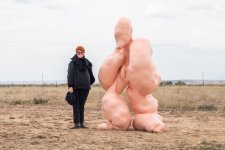Her Majesty Queen Elizabeth II (1926–2022) was the eldest of the two daughters of the Duke and Duchess of York, who later became King George VI and Queen Elizabeth. Born in London, she grew up there and at Royal Lodge in Windsor Great Park, and was ten years old when the abdication of her uncle, Edward VIII, and the consequent accession of her father to the throne made her heir presumptive. At 21 she married Philip Mountbatten, who on their marriage was created HRH Prince Philip, Duke of Edinburgh. In 1952, they set out on a tour of the Commonwealth which was to have included Australia and New Zealand; but on the way, in Kenya, Elizabeth received news of her father’s death. She returned to England and was 27 on her coronation on 2 June 1953. The Head of State of the United Kingdom and fifteen other Commonwealth countries during her reign, she was the first reigning British monarch to visit Australia, making the first of her fifteen visits here in 1954, when she and Prince Philip took in 57 cities and towns between Hobart and Cairns in 58 days. In 2015, she surpassed the record set by her great-great-grandmother Queen Victoria to become Britain’s longest reigning monarch; and on 6 February 2022, the seventieth anniversary of her accession, she became the first ever British monarch to mark a Platinum Jubilee.
Photographer Polly Borland (b. 1959) was one of few photographers commissioned by the Palace to take a portrait for Her Majesty’s Golden Jubilee in 2002. This unconventional royal portrait is one of two resulting from a very brief sitting with Her Majesty at Buckingham Palace. Borland brought two backdrops with her: a piece of floral Marimekko fabric, and a length of sparkly gold lamé-style material she’d purchased from saucy lingerie shop, Ann Summers. ‘The remit was we only got five minutes,’ Borland recollects. ‘We set up two cameras, two backdrops, one in front of the other. The minder came in and I was given this protocol. I could curtsy when she walked in, but I didn’t have to. I could bow when she walked in, but I didn’t have to. And I should call her ma’am.’ Borland was told that her five minutes would start as soon as Her Majesty was in front of the camera. The Queen arrived and ‘all of a sudden, I see this woman, who’s a lot more petite than I’d imagined, a lot more beautiful than I’d imagined, a lot richer than I’d imagined, looking very glamorous … I couldn’t talk, I couldn’t remember anything’, Borland says. With three minutes of her allotted time left – and despite ‘total panic’ – Borland shot two rolls of film using both backdrops, noting that Her Majesty was rather pleased with the glitzy, jubilee-themed gold one. The portrait is now iconic for its witty, contemporary and somewhat irreverent aesthetic, although the artist still thinks ‘it’s a miracle that I got two good photos’.
Purchased 2002
© Polly Borland
This portrait is titled HM Queen Elizabeth II and was created by Polly Borland in 2001. It is a type C photograph on paper and measures approximately 60 cm high by 50 cm wide. It is surrounded by a wide border of white mountboard and a narrow wooden frame. The work is glazed.
The photo is a close up of Queen Elizabeth’s face; bright blue eyes looking directly towards us, against a glittering gold sequined background. Strong white light hits her face from the front, washing out her skin.
Queen Elizabeth’s hair gleams platinum, with soft silvery highlights at the front. Combed neatly straight up off her forehead her hair curves either side of her forehead into gentle curls around her ears. Each ear lobe is decorated with a round white pearl earring.
Light has smoothed away any lines on her forehead. Her eyebrows are faint as they arc over her eyes. Queen Elizabeth has a dusting of pale eyeshadow on her eyelids, beneath which her brilliant blue eyes gaze directly outwards.
Queen Elizabeth has a straight nose with a round downturned tip. Her full cheeks are tinged delicately with pink; creamy and flawless.
Queen Elizabeth’s lips are thin, painted bright coral pink, and partially open, displaying the top row of her even white teeth. Her chin is smooth and rounded. At her throat there are 3 shallow strands of graduated white pearls touching her blue top.
Her pearls disappear at the back of her neck under the collar of her jacket. Both jacket and top are in the same vibrant blue coloured fabric with a subtle sheen. However, the jacket has an intricate check pattern woven into it, while the top has no embellishment.
At the lower right of the photograph, pinned to Queen Elizabeth’s shoulder, is a star-shaped diamond covered brooch. Light reflects from the facets of the white jewels at its centre and 8 radiating points, each interspersed with a further large round gemstone.
Audio description written and voiced by Lucinda Shawcross



On one level The Companion talks about the most famous and frontline Australians, but on another it tells us about ourselves.



Polly Borland talks to Oliver Giles about the celebrity portraits that made her name and why she’s now making more abstract art.



Photographer Polly Borland on capturing Queen Elizabeth II.